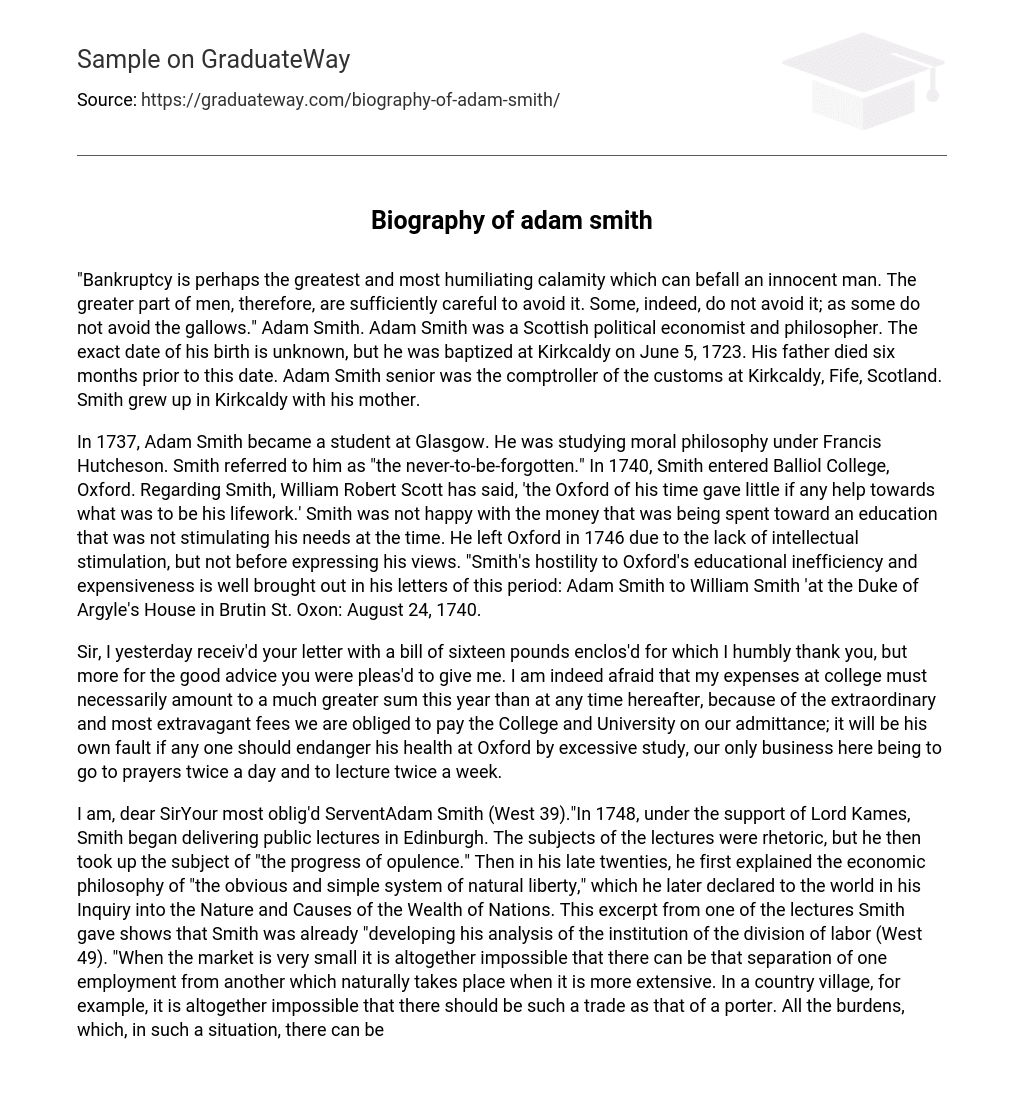“Bankruptcy is perhaps the greatest and most humiliating calamity which can befall an innocent man. The greater part of men, therefore, are sufficiently careful to avoid it. Some, indeed, do not avoid it; as some do not avoid the gallows.” Adam Smith. Adam Smith was a Scottish political economist and philosopher. The exact date of his birth is unknown, but he was baptized at Kirkcaldy on June 5, 1723. His father died six months prior to this date. Adam Smith senior was the comptroller of the customs at Kirkcaldy, Fife, Scotland. Smith grew up in Kirkcaldy with his mother.
In 1737, Adam Smith became a student at Glasgow. He was studying moral philosophy under Francis Hutcheson. Smith referred to him as “the never-to-be-forgotten.” In 1740, Smith entered Balliol College, Oxford. Regarding Smith, William Robert Scott has said, ‘the Oxford of his time gave little if any help towards what was to be his lifework.’ Smith was not happy with the money that was being spent toward an education that was not stimulating his needs at the time. He left Oxford in 1746 due to the lack of intellectual stimulation, but not before expressing his views. “Smith’s hostility to Oxford’s educational inefficiency and expensiveness is well brought out in his letters of this period: Adam Smith to William Smith ‘at the Duke of Argyle’s House in Brutin St. Oxon: August 24, 1740.
Sir, I yesterday receiv’d your letter with a bill of sixteen pounds enclos’d for which I humbly thank you, but more for the good advice you were pleas’d to give me. I am indeed afraid that my expenses at college must necessarily amount to a much greater sum this year than at any time hereafter, because of the extraordinary and most extravagant fees we are obliged to pay the College and University on our admittance; it will be his own fault if any one should endanger his health at Oxford by excessive study, our only business here being to go to prayers twice a day and to lecture twice a week.
I am, dear SirYour most oblig’d ServentAdam Smith (West 39).”In 1748, under the support of Lord Kames, Smith began delivering public lectures in Edinburgh. The subjects of the lectures were rhetoric, but he then took up the subject of “the progress of opulence.” Then in his late twenties, he first explained the economic philosophy of “the obvious and simple system of natural liberty,” which he later declared to the world in his Inquiry into the Nature and Causes of the Wealth of Nations. This excerpt from one of the lectures Smith gave shows that Smith was already “developing his analysis of the institution of the division of labor (West 49). “When the market is very small it is altogether impossible that there can be that separation of one employment from another which naturally takes place when it is more extensive. In a country village, for example, it is altogether impossible that there should be such a trade as that of a porter. All the burdens, which, in such a situation, there can be any occasion to carry from one house to another, would not give full employment to a man for a week in the year.”Smith was at the start of his development of his most famous book, The Wealth of Nations.
In January of 1751, Smith was appointed professor of logic at Glasgow University. He then transferred to the chair of moral philosophy in 1752. Smith’s main task at Glasgow became lectures on moral philosophy. The main subjects of his lectures were ethics, rhetoric, jurisprudence, and political economy. “John Millar, who attended Smith’s classes from 1751-52, said that Smith ‘saw the necessity of departing widely from the plan that had been followed by his predecessors, and the attention of his pupils to studies of a more interesting and useful nature than the logic and the metaphysics of the schools (West 54-5).'” Smith was a man who stuck to his own principles and did not follow those of the masses.
In 1759, Smith published the Theory of Moral Sentiments, which contained much influence from some of his Glasgow lectures. This work established Smith’s reputation and explained moral approval and disapproval. At this point, Smith began to give more attention to jurisprudence and political economy in his lecture and less to his theories of morals. At the end of 1763, Smith obtained a position as tutor to the young duke of Buccleuch and resigned from his professorship at Glasgow. He traveled with his pupil from 1764-66 (mostly in France) where he came to know some intellectual leaders, such as Turgot, D’Alembert, Andre Morellet, Helvetius, and Francois Quesnay. Quesnay was the head of the Physiocratic school whose work Smith much respected. After this traveling, Smith returned to his home in Kirkcaldy. For the next ten years, he spent most of his time working on his book, Wealth of Nations, which appeared in 1776.
In 1778, he was appointed to a comfortable post as commissioner of customs in Scotland and went to live with his mother in Edinburgh. He died there on July 17, 1790, after a painful illness. He devoted a considerable part of his income to numerous secret acts of charity.
Bibliography
- Muller, Jerry Z. Adam Smith. In His Time and Ours. Designing the DecentSociety. Princeton, New Jersey: Princeton University Press, 1993.
- Ross, Ian Simpson. The Life of Adam Smith. Oxford: Clarendon Press, 1995.
- West, E.G. Adam Smith. New Rochelle, New York: Arlington House, 1969.





